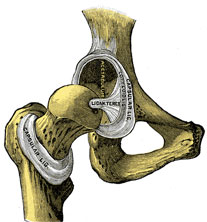
The hip joint is a
ball and socket joint consisting of a concave acetabulum and a covex
head of the femur. It allows for 3° of freedom which includes
flexion/extension in the sagittal plane, abduction/adduction in the
frontal plane, and external/internal rotation in the transverse
plane. The primary role of the hip joint is to support the weight of
the head, arms, and trunk both in the static position and in dynamic
postures such as ambulation, running, and stair climbing (1).
Injuries and other conditions at the hip can result in a loss of hip
range of motion and strength, hip joint hypomobility, and movement
dysfunction. According to the Cyriax capsular pattern hip internal
rotation and abduction are first lost, with hip flexion being more
limited than hip extension (2).
A common treatment approach utilized to treat joint restriction and
limitations at the hip is joint mobilization. The goals of
mobilization are to improve extensibility of restricted
capsuloligamentous tissue and to affect the articular
mechanoreceptor activation pattern at the joint (3). Joint
mobilization has been demonstrated to improve physiologic and
accessory motions to hypomobile structures and increase muscular
strength by removing the reflexogenic inhibition emanating from the
joint mechanoreceptors (3, 4).
In a case report by Crow et al. (5) they conducted a study on a 43
y/o male who underwent bilateral hip resurfacing arthroplasty and
developed severely restricted hip motion. Utilizing a multimodal
treatment approach including exercise with an emphasis on joint
mobilization the patient was able to achieve clinically meaningful
improvements with PROM measurements and functional activities. The
authors noted that further research should be conducted to include
multiple individuals with severely restricted hip motion so
cause-and effect relationship can be established.
In a pilot study by Makofsky et al. (3) they examined the effect of
grade IV inferior hip joint mobilization on hip abductor torque.
Thirty healthy subjects were randomly assigned to a control group
which received grade I inferior hip joint mobilization and an
experimental group which received grade IV inferior hip joint
mobilization. Their study revealed that there was a statistically
significant difference between the two groups for an increase in hip
abductor torque and was consistent with other studies demonstrating
that the use of a grade IV non-thrust mobilization improves strength
immediately post intervention in healthy individuals.
In another study by Yerys et al (6), they conducted a study to
determine the usefulness of posterioranterior (P-A) hip joint
mobilization in improving strength of the gluteus maximus muscle.
Forty asymptomatic subjects were randomly assigned to a control
group which received Grade I P-A mobilization and an experimental
group which received Grade IV P-A mobilization. The results of the
study demonstrated a statistically significant difference between
the hip extensor torque of the two groups with a 14% increase in
strength for the experimental group and only a 4% increase in
strength for the control group.
Given the importance of practicing based on evidence and the
positive findings in the above studies and many more studies,
physical therapists should feel comfortable to consider the
utilization of hip joint mobilization techniques to facilitate not only
increasing range of motion at the hip but strengthening as well.
|
A review of some hip mobilization techniques
can be found below (7, 8)
(please note that there are alternative methods to
performing these mobilizations): |
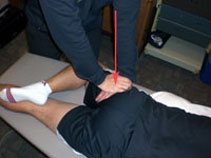
Anterior Glide
of the Hip Joint - Patient is lying prone with one or more
pillows under the trunk and the hip positioned in abduction and
external rotation. Place the guiding hand over the posterolateral
surface of the proximal thigh and then the mobilizing hand over the
guiding hand. The mobilizing/manipulating hand glides the femur in
an anterior direction as the therapist leans on the patient's thigh.
|
| |
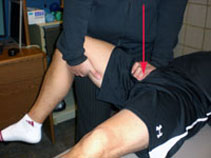
Posterior Glide
of the Hip Joint - Patient is lying supine and the therapist is
supporting the patient's knee with the guiding hand. If conservative
techniques are indicated the hip joint is placed in the resting
position. If more aggressive techniques are indicated the hip joint
is placed in the approximately restricted range of motion. The
mobilizing/manipulating hand is positioned on the anterior surface
of the proximal thigh. The therapist applies a grade I traction to
the joint and the mobilizing/manipulating hand glides the femur in a
posterior direction.
|
| |
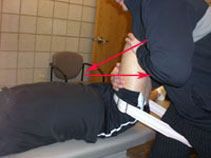
Distraction/Inferior Glide
of the Hip Joint - Patient is lying supine near the edge of the
table with belt wrapped around the patient's leg and the therapist's
leg. In a lunge position with therapist facing patient, therapist
applies a light distraction force by taking taking up slack in the
belt while moving the patient's hip into flexion.
|
| |
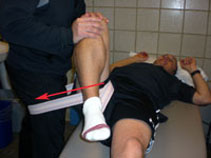
Lateral Glide of
the Hip Joint - Patient is
lying supine near the edge of the table with belt wrapped around the
therapist's leg and the patient's leg as low as patient comfort will
allow. In a lunge position with therapist facing the lateral aspect
of the patient, therapist applies a light distraction force by
taking up slack in the belt while moving the patient's hip into
flexion.
|
Last revised: January 15, 2010
by Jennifer Hill, MPT, CSCS & Chai Rasavong, MPT, MBA
References
1. Norkin CC, Levangie PK. (1992). Joint Structures & Function - A
Comprehensive Analysis - Second Edition. Philadelphia, PA: F.A. Davis
Company.
2.
http://www.om-cyriax.com/577-glossary/Capsular-pattern.htm
3.
Makofsky H, et al. Immediate Effect of Grade IV Inferior Joint Mobilization
on Hip Abductor Torque: A Pilot Study. The Journal of Manual & Manipulative
Therapy. 2007;15(2):103-111
4.
Warmerdam A. Arthrokinematic Therapy: Improving Muscle Performance
through Joint Manipulation. Wantagh, NY: Pine Publications, 1999:32–44.
5
Crow J., et al. Use of Joint Mobilization in a Patient With Severely
Restricted Hip Motion Following Bilateral Hip Resurfacing Arthroplasty.
Physical Therapy. 2008;88(12):1591-1600.
6.
Yerys S, et al. Effect of
Mobilization of the Anterior Hip Capsule on Gluteus Maximus Strength. The
Journal of Manual & Manipulative Therapy. 2002;10(4);218-224.
7. Edmond, S. Joint Mobilization/Manipulation - Extremity and Spinal
Techniques Second Edition. St. Louis, MO: Mosby Elsevier, 2006.
8.
http://video.nata.org/gettingfunctional/handouts/handout5.pdf |












